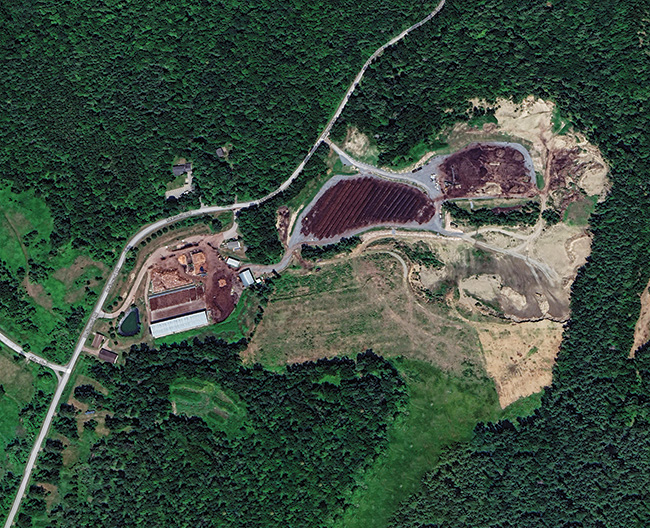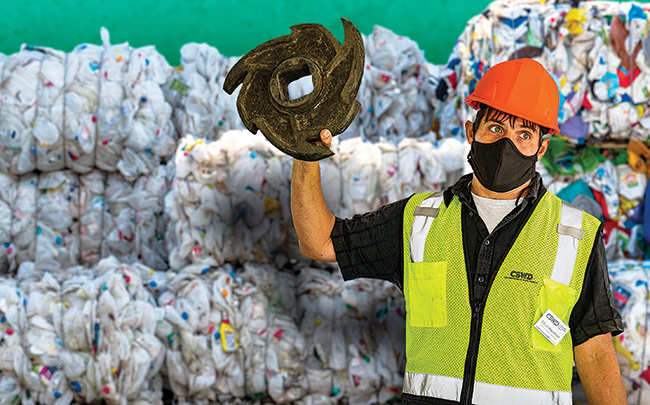With a mission to reduce and manage the solid waste generated within Chittenden County in an environmentally sound, efficient, effective, and economical manner, CSWD’s three decades of educating the population and continually seeking opportunities for how they can make diversion of waste from the landfill has led to an average 57 percent MSW and C&D diversion rate.
Chittenden Solid Waste District (CSWD) in northwest Vermont is a municipal district created in 1987 by member towns and cities to implement solid waste mandates legislated by the state of Vermont on their behalf. CSWD is the largest solid waste district in Vermont, serving all 18 towns and cities within Chittenden County. Members include roughly 168,000 residents (25 percent of the State’s population), 7,500 businesses, several large institutions, and tens of thousands of seasonal visitors and tourists. CSWD is not a department or agency of state government, rather a Board of Commissioners representing each community within the district provides financial and policy oversight.

CSWD’s mission is to reduce and manage the solid waste generated within Chittenden County in an environmentally sound,efficient, effective, and economical manner. This includes providing information to the public about private and public programs and facilities in addition to district owned and operated programs and facilities.
CSWD employs roughly 48 full-time staff. Facilities include Vermont’s largest food waste composting operation (where Green Mountain Compost soil amendments are produced and sold), the only publicly owned MRF in Vermont, a permanent, year-round household hazardous waste collection facility that also produces Local Color brand recycled paint, a seasonal mobile unit called The Rover that provides one-day HHW and paint collection within member communities, and six drop-off centers located around the county for household trash, “blue-bin” recyclables, food scraps, and other landfill-banned “special recyclables” not commonly collected by curbside hauling services. These facilities serve communities that reach far beyond the District’s geographical boundaries.
Providing educational outreach and resources as well as technical assistance for members, CSWD also performs compliance and enforcement actions as needed to ensure compliance with state mandates and the District’s own Solid Waste Management Ordinance.

A Different Approach
The collective experiences of the past two years have changed how CSWD staff approach their work and engage with the public. “We’ve reviewed our wage structure to ensure that we are still providing a compensation package that is competitive in today’s market. Remote work for our administrative team remains in place for all who want that option,” says Executive Director Sarah Reeves. “At the beginning of the pandemic, we implemented a CV-19 protocol consistent with CDC guidelines, which included mandatory masking for employees, safe distancing for customers, temperature checks, etc. We also consolidated some services to our largest location to reduce time onsite for customers in our smaller centers.” In addition, CSWD implemented an online appointment system at their HHW facility to regulate the flow of material and customers and to encourage more efficient use—consolidating trips—by customers.
Though the District has begun to modify some practices—reinstating bulky waste collection at their most remote drop-off center to reduce customer travel and improve convenience—they are encouraged by the benefits seen from the HHW appointment system. “The system provides more predictability and less stress for our staff and less waiting and idling for customers,” says Director of Compliance and Hazardous Waste, Josh Estey. “Plus, our data appear to show a positive trend for HHW management. We collected the third-highest volume of waste in the history of the program while managing significantly fewer customer trips.”
Currently, CSWD is dealing with the challenge of hiring employees for certain positions, like truck drivers and maintenance staff, even with a healthy municipal wage and benefit structure. Like everyone else in this market, they have increased starting wages in the most competitive fields and are using every avenue available to find candidates.

Supply chain pressures have also increased their costs, causing capital project prices to soar, so they are potentially delaying some large equipment purchases and are finding ways to trim the costs of other projects. Instead of establishing a new wood waste depot on an undeveloped site, for instance, they are revamping the current leaf and yard debris area of the compost site to incorporate the wood, which will be ground onsite for use as a compost feedstock. “Though it isn’t our ideal scenario, we’re saving tens of thousands of dollars in permitting, road building, and other development costs,” notes Director of Composting, Dan Goossen.
A Cautious Balance
In the northeastern U.S., by far the most densely populated region in the nation, long-term local disposal options are diminishing. The region has among the highest costs for MSW disposal in the country. They also have some of the tightest environmental laws and policies. “We need to look at modern disposal options that will satisfy the needs of the 57.5 million people who live and work here,” says Reeves. “We also adhere to not just the rule of the laws, but the spirit as well.”
Perhaps not surprisingly, the success of three decades of educating the population and continually seeking opportunities for how they can make diversion of waste from the landfill as convenient and accessible as possible, has led to an unwieldy and probably unsustainable scope of services. “Consequently, we are now wrestling with how to continue to provide services that our residents and businesses have come to expect, at a sustainable price,” explains Reeves, who was hired as Executive Director in 2016.
“As all costs continue to rise,” says Reeves, “we are focusing on providing the most needed services that are most central to our mission and either are not provided by the private sector or that demand a public sector presence to ensure affordable and accessible options. We are also looking at significant capital investments to shore up and/or replace aging infrastructure. All of this means we are fast approaching a time where we’ll need to eliminate any nonessential ‘extras’ from our workload. It’s a difficult balance.”

Successful Management
CSWD believes they have always “punched above their weight,” as shown by their leadership in HHW and paint management as well as being among the first in the country to advocate for, and continue to provide, expertise on some of the country’s most forward-thinking EPR legislation. The Director of Public Policy and Communications, Jen Holliday, was a founder and is current Chair of the Vermont Product Stewardship Council.
“The proof of this is in our community’s estimated 57 percent MSW and C&D diversion rate as well as our estimated 81.5 percent recovery rate for blue-bin (aka mandatory) recyclables in 2020,” says Michele Morris, Director of Marketing and Communications.
The District budgets for training and continuing education in every department and has a long-standing commitment to safety as evidenced by an annual facility-wide shut down for full staff safety trainings and a Total Recordable Incident Rate (TRIR) that is consistently below the industry average. “We are very pleased to have recorded zero OSHA recordable injuries in 2021 despite more than 80,000 work hours logged,” reports Estey.
Internal committees on innovation, wellness, and equity and inclusion complement the safety committee to stay ahead of challenges common to the waste and recycling industry. “We’re confident that our nearly 30 years of education and outreach have contributed significantly not only to our high diversion rates, but also to the incredibly low 7 percent residue rate we see at our MRF,” says Morris. “CSWD’s commitment to this includes full-time staff dedicated to schools, businesses, and events/community outreach as well as a three-person marketing team.”
Reeves is cautiously optimistic that this work has laid a solid foundation for the District’s capital planning outlook: “We are extremely excited about our plans for a new greenfield MRF to replace the facility we built in 1993. We will be presenting a bond vote to Chittenden County voters in November and are pursuing numerous funding options to ensure that request is reduced as much as possible by the time we go to the voters.” | WA
For more information, contact Michele Morris at (802) 872-8100, ext. 237 or e-mail [email protected].
